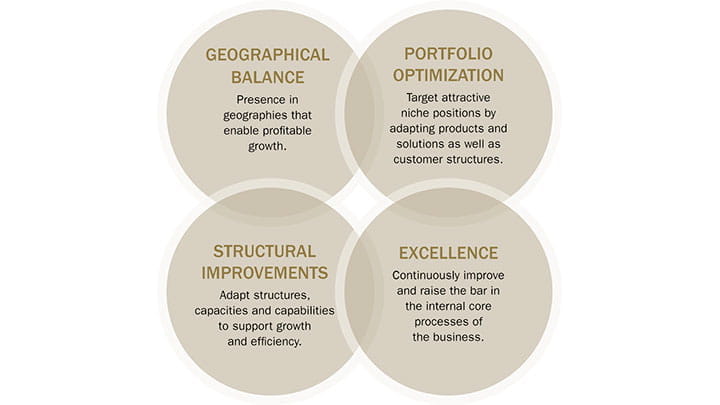Trelleborg’s strategy for leading positions
Trelleborg’s strategy is to secure and build leading positions in selected industries. These positions are developed by continuously working on the basis of the four strategic cornerstones described below.

Geographic balance
Proximity to customers with a complete offering
Trelleborg sees strength in its ability to combine a strongly decentralized and local organization with the capabilities of a global Group. Business decisions are made close to the customer, providing flexibility as well as market and customer knowledge. A geographical balance reduces the impact from fluctuations in the economy and currencies or from trade barriers. The extensive local presence of Trelleborg means the Group does not have significant export flows. Trelleborg has operations in some 40 countries with approximately 100 manufacturing units and sales to just over 140 countries. The geographical balance has changed significantly over the last decade. In the past, Europe dominated and accounted for three quarters of sales. In 2023, Europe represented around 46 percent of sales with North and South America representing 35 percent and Asia and other markets 19 percent. This provides better exposure to high-growth regions.
Portfolio optimization
Presence in profitable, growing segments
The Group is working systematically to identify those positions that have high growth and, in parallel, the potential for good profitability. The optimization work includes choosing where to focus the portfolio and identifying gaps in our existing offerings. This may involve expanding offerings, developing new applications or targeting new technologies or niches.
Structural improvements
Right place for right operation
Trelleborg’s focus is on developing its operations and localizing them to areas where Trelleborg can grow and recruit the right talent and do the best job. However, it is also about developing offerings that make life easier and increase value for customers, as well as developing and working within new business models.
In 2023, Trelleborg increased investments in its existing operations. For example, tunnel seal manufacturing has been moved from the Netherlands to China and Singapore, while
sales and the Engineering Excellence Center remain in Rotterdam in the Netherlands. To address growing demand, new facilities have been built for antivibration solutions in China and automotive boots in France. In Bulgaria, an expansion of an existing facility enabled a doubling of the production of precision seals.
Excellence
Excellence in core processes
Trelleborg has a systematic internal procedure to further improve core business processes. This is done through training via Trelleborg Group University and through customized efficiency tools that are deployed across the business.
Megatrends impacting Trelleborg
The Trelleborg Group is impacted by a number of megatrends that create business opportunities but also drive change across the business. These trends are characterized by the fact that they are based on global patterns and that they are already evident today, but are expected to play an even larger role in the longer term.
World growth is moving eastward. According to the International Monetary Fund (IMF), the Asia-Pacific region accounted for nearly two-thirds of global growth in 2023. International trade connects a world in which raw materials are often extracted in one country and processed in another, before the end products are then shipped to customers across the globe. Global trade places high demands on worldwide value chains. At the same time, trade has developed in a more protectionist direction, requiring a greater local presence with production in the regions where sales are conducted. This development is also affected by a more uncertain world, where tensions between countries and regions are increasing. The world’s population is aging and for the first time more than 10 percent of the population is now over 65, thereby increasing the need for health and medical care, which is estimated to account for more than one tenth of global GDP, according to The Economist.
The world is in the midst of a transition of major proportions to reduce climate emissions, while scarce natural resources are creating challenges. However, the pace of change in industry is high, creating a growing demand for products, services and applications that increase energy efficiency, extend service life and reduce emissions. The Paris Agreement’s goal of limiting global warming to 1.5°C requires businesses and society to think in entirely new ways. Above all, it is about improving energy efficiency and replacing fossil fuels with both renewable and fossil free energy sources. Developments in renewable energy and sustainable fuels are creating industries with new needs for applications and solutions.
Migration to large cities is taking place in many parts of the world and is particularly evident in emerging markets. The UN estimates that the population of the world’s cities will grow by 2.5 billion by 2050. The trend will increase the demand for more efficient cities, which will also need to adapt to mitigate the impact of climate change. This will require major investments in infrastructure, where there are currently large gaps between needs and investments. The need for mobility, for shorter distances within and between cities but also for longer trips, is expected to increase for both work and tourism. In this area, there is a rapid development of services and fuels taking place, as well as vehicles equipped with increasingly advanced self-driving technologies.
The rapid pace of technological development in general and AI in particular will have a major impact on society as a whole and not least on industrial processes. These will be able to become more efficient and reduce their impact on the environment. At the same time, the level of automation is increasing in both industry and society. Growth in the IT sector is expected to be strong in cybersecurity, but higher demand for hardware is also expected, which will increase the need for advanced semiconductors. Digital developments are
also expected to continue to have major implications for customer offerings, sales, administration and communication.






